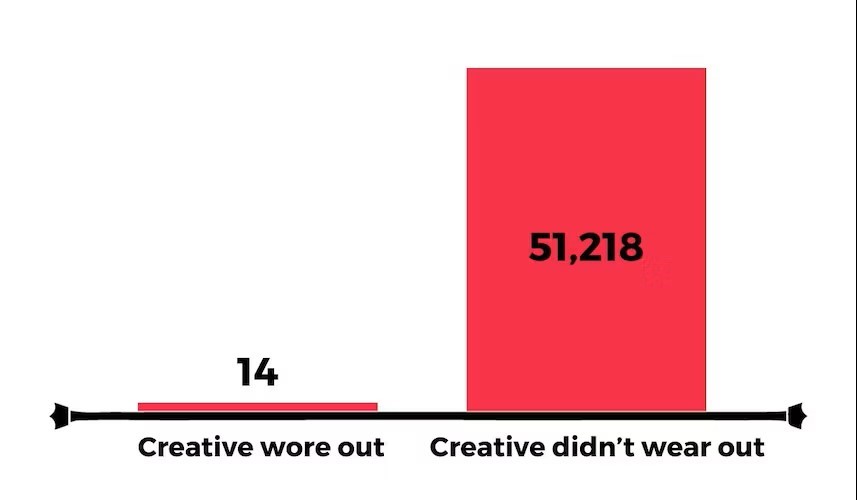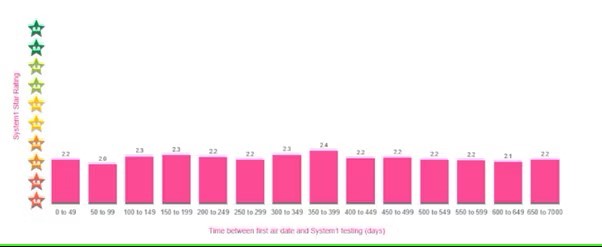
Well, if that blog headline doesn’t get music radio’s attention, nothing will.
And it’s not meant for just practitioners of commercial radio’s music stations. It applies 100% to Christian radio and public radio stations that play music, including jazz, classical, Triple A, Americana, and yes, your urban alternative stations that have been springing up during the last five years.
So, where do I get off making this claim and why do I think I’m right?
First and foremost, some qualifications. Today’s blog post was inspired by an article that appeared in Marketing Week earlier this month, written not by a music programmer, a record company executive, a music researcher, or even a musician.
The author is Mark Ritson who holds a PhD in Marketing and has taught at business schools, including MIT. And full disclosure, the title of his column was:
“Consumers don’t get tired of ads, only marketers do”
I can tell you it’s one of the best marketing articles I’ve read in some time, largely because I agree with almost all of it, and it has a certain logic that should resonate with both marketers and radio programmers.

Now, you can tell me – and some of you most certainly will – that you cannot compare the wear and tear of an advertising campaign with that of a current (or classic) song. But after reading Ritson’s theories, I’m not sure why you can’t, at least to a degree.
Why does this matter? Because CMOs often walk away from an inherently effective campaign because they’re tired of it and because “Look how long we’ve been running it” paradigms.
Radio music directors and PDs aren’t all that different. It’s been said – and I think rightfully so – that people who work for stations listen to their own stations much more than normal people do (or that is healthy).
In ad world, Ritson calls it “wear-in,” the degree to which a campaign or ad has stayed too long at the party. In radio it’s “burn-out.” Same thing.
The more pragmatic among us may say, “But what about all that ad/music research we do? ”
ad/music research we do? ”
Isn’t that the great leveler? Isn’t there some sanity in all those Scantron sheets? After all, measuring “wear-in/burn-out” ought to provide the best metric for facilitating good decision-making.
Except that both research regimens are flawed. In the former, ad research teams often use college tests as their guinea pigs. Ritson shoots holes in both methodology and the idea that campaigns tend to follow the same cycles of exposure, repetition, and wear and tear. And of course, campaigns (er…songs) are going to hold up or fry at different rates.
Exposure may be the most important variable. Back in the pre-Internet days when yours truly last programmed, the only places consumers could hear a song was on a radio station or two, MTV (if it was newish), and on their own turntables and CD players.
Today’s cross-platform exposure – especially streaming because it is on-demand rather than linear – is a literal game-changer. And yet, radio is testing for so-called fatigue essentially the same way we did when Bob Pittman was a long-haired PD.
“And are you tired of it?” is no way to measure a song’s continued contribution to your playlist any more than learning the CHR down the dial just added the song you “broke” and have been banging into a hit.
But let’s look at the research – at least the ad stuff. Ritson points to research by Analytic Partners’ 2022 ROI Genome report as the first data point that indicates most marketers (I’ll let you fill in the radio analogy) have no idea what they’re doing.
They measured wear-out among 50,000+ ads and they learned this;
Most aren’t suffering from wear-out.
In fact, only 14 of the 51,000+ ads tested turned out to be fried. The rest? Still lots of tread on the tires.

And yet, most marketers are inclined to move on and create something new. Or in the words of the great philosopher Amplifi Media’s Steve Goldstein:
“It was working so well, we stopped doing it.”
In the radio world where audience research has become something of a rarity, there’s preciously even less data justifying dropping a song down to recurrent or putting it “on hold,” a limbo state where it will only enjoy millions of streams but won’t be heard on the radio.
As Ritson concludes, “The problem of wearout is one of the marketer, not the market.”
A little creative editing and we’re talking radio, songs, and bored programmers.
In another demonstration of research fallacies, Ritson turns to a study by System1 measuring the same ad and its ratings over time – when it first comes out and more than two years later:

That’s right – the scores are statistically the same over a relatively long period of time for a new ad campaign – or a new song.
Ritson ends his articles with several well-crafted “takeaways for marketers,” several of which don’t directly apply to the art of programming radio stations, picking and retaining songs.
But his first admonition – “Learn patience” – is spot on. Whether you’re a marketer or a designer handbag brand or you program a country station in Jacksonville, Florida, slowing things down and “learning the patience of the market” is key.
Ritson nods that we get too close to the product – in this case, the music. All that focus and passion can burn us out before the audience even remembers a song (or an ad) in the first place.
He also reminds “new marketers should resist new campaigns.” And to that, I wholeheartedly suggest stations whose position it is to play new music should still pump the brakes.
That’s not to say that if you’re a mainstream rock station and a new Foo Fighters lands on your credenza, you should sit on it and give it a think. But something new, bubbling under, unproven, streaming a good amount, and trying to break out deserves a degree of patience – especially to make sure you have enough rotational resources to adequately expose the playlist you submitted last week, much less a brand new song by an unknown artist.
Ritson also suggests “Looking backwards before you head forward.” Your gold library may hold more firepower than you think, especially these days when your audience will scarf down any comfort food you put in front of them.
 And finally, a piece of free advice from your friendly consultant (so you know what that’s worth): “You are not the center of the universe.”
And finally, a piece of free advice from your friendly consultant (so you know what that’s worth): “You are not the center of the universe.”
The only people who know you just added a song are you, your MD (maybe that’s also you), the label, and the trades. Listeners don’t treat your station like a “one stop shop” where they use you exclusively to hear what’s new and what’s next. In fact, you now may be one of the last stops on the new music express. All in all, another brick in the wall.
That’s OK. Know your place in the hierarchy, and program accordingly. You don’t have to first in order to win, but you have to be great without getting too far out in front of the field.
- Who’s Got It Better? Talent In Commercial Radio vs. Talent in Christian Music Radio - June 4, 2025
- It’s The Christian (Radio) Thing To Do - June 3, 2025
- Is It Time For Radio to WAKE UP?! - June 1, 2025




Triple a audiences expect a healthy dose of both, but the currents category is extremely competitive. In this case, I will agree that even a great song that goes to power, falls off at its hottest point. Dial Drunk is a good example. I think there are nuances here, but interesting take, though I think some take it to extremes. I think they get sick of peak rotation, not songs, a problem that Ac solves in part.
Listen to what people say, but trust what they do.
Very interesting, Fred. But I’ll play devil’s advocate: Why do I listen to my favorite music stations? Because their musical tastes align generally with mine and they have access to more new music than I do–and I like new music as well as “catalog,” otherwise I would listen only to an oldies station (or Pandora).
So when these trusted professionals at my favorite station are getting tired of something, chances are pretty good that I am, too, and they just beat me to the punch by adding the next bright, shiny object; which there’s a decent likelihood I’ll enjoy hearing. And if they’re really good, they’ll still bring the retirees back now and then to remind me why they’re my favorite station in the first place. After all, that the PD thinks a tune is fried doesn’t mean he thinks it’s bad (heck, he put it into rotation earlier, didn’t he?); it’s just a bit shop-worn. Make room for the next contender.
Just because a song tests well doesn’t mean listeners want to hear it every damn day. And why can’t jocks wrap the song with interesting factoids instead of “here’s The Who”?
Fred,
As a music lover I owned what I played, and when the tunes became so beaten into my brain I admit I lost the plot. Corporate radio knocked the spirit out of me, and I was replaced with a younger, cheaper version of me.
Now I can laugh about the call I got during a show on my cell from a good friend who just said “Tai – Pablo Cruise?” and chuckled. He tried to listen to me every day because he respected me as a jock, but the playlist and tested songs won out. I will always admire those who pick up and move out of the market, as that would have been a better solution for me looking back.
Ironically, decades later it was the same station that my non-radio workplace embraced for a market-tradition morning show with familiar playlist. But it ultimately drove listeners away when thoughtless personnel changes and relentless repetition made it just plain annoying. More faithful fans driven to Spotify.
Listen for trends, know the audience, the artists, station appeal and play the hits. Research isn’t fool proof (some folks can’t name that song by hearing a hook – Boz Scaggs, Steely Dan). Use history and your ears objectively. What were once album cuts are now familiar hits – Landslide, Moondance, Here Comes the Sun. And, never forget the All Time Great Classics with the right blend and connected presentation.
When you’re getting sick of it, the audience is just getting it.
I learned that early in my programming career, Tim. Thanks for saying it. We do, as Fred says in his post, listen to our stations far more than the TSL numbers for our actual audience.
This goes along with the armchair quarterbacks who claim songs have “burned to a crisp” and that “everyone” is tired of them. I have developed a stock answer for them:
“If the audience was tired of these songs, they wouldn’t still be listening.”
Trust your TSL and cume. If they remain relatively constant from ratings period to ratings period, there’s nothing wrong with continuing to play those songs, regardless of what the outliers try to tell you.
As for me, programming Classic Hits, I only put songs into “hold” for a limited (and specific) number of reasons: (1) If a core title seems to be losing steam I will hold it and watch the research to see if it rebounds in a reasonable amount of time, and if it doesn’t it’s then rested enough to be a droppable fill; (2) if those fill titles start losing steam I will again hold and watch and if they don’t warrant reinstatement as fill titles I let them rest for several months and then add them to my “Forgotten 45” category; (3) F45 songs play about a dozen times over a three week active period and then rest for a minimum of six months before I consider playing them again; (4) I have automatic rest periods built into the “deeper tracks” category of our Flashback Weekend all-New Wave program.
That seems to be working here … at least when I look at the trends in our TSL and cume. (Oh, wait, I already said that, didn’t I?)
Absolutely K.M. And if all else fails, call Fred.
I knnow I’ve heard that famous mantra somewhere before! 🙂
Even though it’s counter-intuitive, you are dead on, Tim! I learned that early in my career, and when you get out and TALK to “civilians” (i.e., not radio professionals), they generally aren’t anywhere near as tired of the songs as we are. There are some exceptions, but we always have to remember that we pay far more attention to our playlists than the average listener.
Great to hear from you, Corinne. And thanks for sharing your experience.
Hey! Teacher! Leave them kids alone!
How can you get any pudding when you don’t eat your meat? (OK, I’ll stop.)
My early experience and training were first in Beautiful Music (FM 100) and Album Oriented Rock (KLZ 107) here in Denver in the late 1970’s and pre-AAA 1980’s.
I had (still do) a very deep voice that easily disguised the the fact that I was just a kid.
My retired business partner and his wife in fact founded KBCO (more on that another time).
When at FM 100 one of my jobs was to shred the program logs (commercials too) after the required FCC retention time expired.
The manager of the station was obsessed with this process and only later I truly understood why.
This was our secret sauce.
Right down to the advertiser and station imaging rotation was our proprietary mix of how one artist blended into the next.
Our programming consultant (Jim Schulke) put it this way, “listeners in our core adult demographic never tire of their favorite song.” He continued in a note he wrote to me in 1983, “unlike Top40 we rely on music preferences that emulated a lifestyle, mood and memories.”
I read a study when building my current radio station that the average streamer listens to basically the same 500 songs over and over and only adds new titles when a new artist or song mirrors the user’s personal preference.
Food for thought when tinkering with perfection.
Chucck, you learned fromr one of the best, an artisan. Thanks for sharing that lesson. I wish you shared it with me a few decaades ago. 🙂
Free Bird. Sweet Home Alabama. Stairway to Heaven. An occasional one-day truce would be a reasonably compassionate break.
If you are hearing those songs literally every day, one of two things is the reason … either (1) you have a much higher TSL than the average listener; or (2) the station isn’t setting the separation between plays properly to bounce those songs between dayparts and hours within those dayparts.
Either way, the reality is that, as I said in my earlier comment: The audience doesn’t keep listening if the songs are burning out.
And that leads me to believe that you’re one of those “armchair quarterback” outliers I referenced. Or you’re trolling us.
Thanks for that last piece of advice, Fred. We should all realize we’re not the center of the universe The GM’s wife is
Touche!
Back in the Jurassic Age, when I was first testing spots (and music), I learned something curious: Those Crazy TV Eddie/Lenny and all the impersonators, were horrible spots that people were “sick of,” right up until the time that they were interested in purchasing a TV, stereo, etc. Then those ads that they “hated” suddenly became “informational.”
For the most part, what people are “sick of” are songs, spots, that they never liked and now have heard enough times to know from start to finish on top of.
I can watch the Geico gecko for the zillionth time and still get an occasional chuckle. Flo, and the Progressive spots. Oh, I’m sick of her, but come to think of it, I despised the concept from the first time I ever saw it. Much more “never liked it” than “burnt,” if I’m being honest.
Like great songs, those ads (even Kars-4-Kids sadly) get in our heads. We can even sing the jingles years later. It’s not exactly the same as music, which most people enjoy. But the principles of reach & frequency are very much on display.
I suspect ad execs are, in many cases, angling for new spots to increase revenue on the creative side.
In radio, I’m reminded of jocks whining, “Oh gawd, if I hear ‘Drops of Jupiter’ one more time, I’ll kill myself!” in a staff meeting on the day the album was released.
Exactly, Jim. (Good to hear from you BTW!)